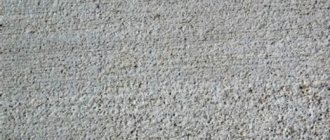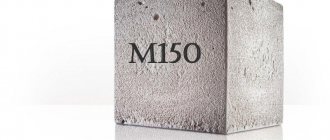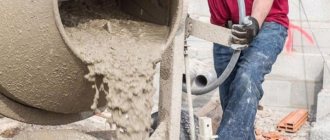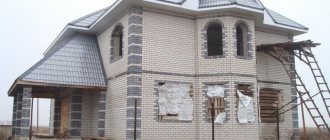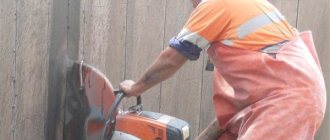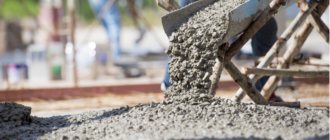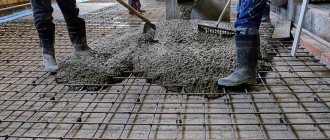Scope of application
High strength characteristics make concrete unprofitable for the construction of residential buildings. The price of the finished solution is quite high, so private developers prefer to use cheaper grades (for example, concrete grade M300). M450 is used for arranging special structures:
- Manufacturing of runways for airfields and airports;
- Low casting of bridge supports, overpasses;
- Construction of subways, tunnels;
- Construction of hydraulic structures such as dams, dams;
- Construction of bomb shelters and bunkers.
Scope of use of concrete M450 B35
Concrete of this brand is practically not used in individual construction. An exception may be work that is carried out in areas prone to seismic hazards and various geological phenomena: landslides, sinkholes and soil subsidence. The structures withstand significant vibrations of the earth's crust and are resistant to vibration and other unfavorable factors.
Under standard conditions, concrete M450 (B35) is used for strengthening and construction of the following types of structures:
- bridges, including railway bridges;
- dams, dikes and other hydraulic structures;
- load-bearing elements subject to constant load;
- metro tunnels and communications;
- bank vaults.
Adding metal shavings to the solution gives the finished elements the ability to protect against radioactive radiation, which is why M450 B35 concrete is often used during the construction of nuclear power facilities.
Description of the main characteristics
High-strength mortar is used for the construction of highly reliable structures, therefore laboratory tests of all stages of mixture preparation are mandatory. The basic requirements for technical indicators are regulated by state standards 10180-2012, 7473-2010.
M450 characteristics:
- mobility P3-P5;
- hardness Zh3-Zh4;
- density 2500 kg/m³;
- strength 458 kgf/cm²;
- strength class B35;
- frost resistance F200-400;
- waterproof W10-14.
Technical indicators can be slightly adjusted by changing the proportions and adding excipients.
B35
2. Concrete B35[*GOST 8736-93] at a favorable price belongs to the heavy category with a high compressive strength. The value varies within 458 kg/sq. cm. A large amount of a binder component of the appropriate brand is introduced into the solution, that is, from M500 to M600. The strength indicator is 2,500 kg per cubic meter. m., which is influenced by the added cement. An important ingredient is granite, which acts as a coarse filler. Without this component, it is impossible to produce good material with standard characteristics for a responsible design. To ensure maximum ease of installation in production, plasticizers are introduced. These components also influence the setting speed. Those. the requirements are described in GOST 26633-2012.
Peculiarities
When hardened, the solution increases the level of frost resistance and water resistance, but reduces the thermal insulation properties. The mixture hardens completely in 21 days at a temperature of 15-25 degrees. The use of M450 frees builders from heavy mixing of components due to the rapid setting of the solution.
Material ratios
M450 is distinguished from popular brands of concrete by the proportions of its components. Cement is the predominant binder to create a high-strength mixture. Mass composition of the solution for M400:
- 1 part cement;
- 1.1 part sand;
- 2.5 parts crushed stone;
- 0.5 parts water;
- 5% plasticizer.
For brand M500:
- 1 part cement;
- 1.4 parts sand;
- 2.9 parts of crushed stone;
- 0.6 parts water;
- 5% plasticizer.
In volumetric parts for M400:
- 1 part cement;
- 1 part sand;
- 2.2 parts of crushed stone;
- 0.3 parts water;
- 5% plasticizer.
For M500:
- 1 part cement;
- 1.2 parts sand;
- 2.5 parts crushed stone;
- 0.4 parts water;
- 5% plasticizer.
Composition and proportions
Figure 3. Application of concrete M450
The characteristics of concrete M450 (B35) are determined by the ratio of the components in it. The B35 mixture contains a large amount of cement grade M500 or 600, which ensures unsurpassed strength properties. There is also sand here. It is pre-cleaned of clay and organic inclusions. Their presence can reduce its characteristics.
As for crushed stone, B35 concrete requires granite. Its fraction is 0.5-2 cm. This component makes the solution more expensive. The standard ratio of ingredients is: 1:1.1:2.5 (binder, sand and filler). The maximum quality of concrete M450 can only be obtained in industrial conditions.
To get 1 cubic meter. mixture B35, it is required to use 405 kg of Portland cement M500-600, 860 kg of sand, 1075 kg of fine granite filler, 184 liters of water. The amount of liquid may vary depending on the desired thickness of the substance. As for plasticizers or other polymer additives, about 9.5 kg will be required.
The solution is transported in mixers with constant stirring to prevent it from instantly setting or separating.
Advantages and disadvantages
Advantages of M450:
- strength;
- frost resistance;
- increased wear resistance;
- waterproof;
- safety.
The disadvantages of the solution include high cost, rapid hardening, and the inability to make it yourself. A prerequisite is the presence of plasticizers.
High-strength, resistant to low temperatures, exposure to water and ultraviolet rays, and aggressive environments, the solution has a limited scope of application. Using the mixture in private construction is unprofitable, although sometimes a series of pools are filled with M450.
How the price of M450 B35 concrete is determined
The cost of the material depends on the raw materials used in its manufacture. The relatively high price of concrete grade M450 B35 is due to the fact that the solution consists of high-quality elements:
- granite crushed stone of the same fraction;
- thoroughly cleaned sand;
- large amounts of cement;
- special plasticizer additives.
The price of the solution may include the rental of special transport for delivery. Compliance with transportation rules allows you to keep the fresh mixture from setting and hardening. Also included in the calculation is the price of a concrete pump , which will ensure rapid supply of the solution to the work site.
The price list will provide up-to-date, most complete and useful information on the cost of concrete grade M450 B35.
Detailed information by phone
Yalta +7 (978) 843-82-22 Sevastopol +7 (978) 727-18-03 Inkerman Opolznevoe
Characteristics
- Frost resistance class F300
- Strength class B 35
- Mobility from P3 to P5
- Waterproof W8-W12
The composition of concrete M-450 includes cement grades 400 or 500, sand and crushed stone. One of the necessary conditions for the strength of concrete is the use of first-class quality fillers; sand and crushed stone are washed in order to remove foreign objects and contaminants from them. This allows you to achieve the necessary coupling of all components. Another necessary ingredient is plasticizers. Manufactured in compliance with all technological conditions, concrete M-450 acquires high characteristics of frost resistance, mobility, and water resistance. At the same time, due to the special formula, its thermal insulation qualities are reduced, which once again speaks against its use in the construction of household objects. The fact that concrete is highly waterproof allows it to be used in the construction of hydraulic structures.
Concrete is also used in cases where structures are erected in places with periodically changing water levels. When producing M-450 concrete, the introduction of compacting additives is not required, but to slow down the hardening rate, which interferes with the construction of monoliths, special additives are added to the mixture. Complete hardening of concrete occurs within three weeks.
Characteristics of concrete grade M-450 for the construction of storage facilities, subways, dams, dams
For concrete grade M450 GOST 7473-94 “Concrete mixtures. Technical Specifications" defines clear parameters according to which it must meet the following criteria:
- mobility of the material – P3-P5 (important until the moment of hardening and depends on the amount of water);
- hardness – Zh1-Zh4 (important until the moment of hardening);
- water resistance – W6-W14;
- frost resistance – F200-F300;
- strength - B35.
According to GOST 7473-2010, class B35 (M450) concrete has a pressure resistance of 35 MPa and a strength of 458 kg/cm2.
SNiP 5.01.23-83 determines that its composition should include: cement (according to GOSTs 10178-76 and 22266-76), sand (GOST 8736-93), granite crushed stone and sometimes gravel, as well as additives in the form of plasticizers, which must comply with TU 5745-001-85789667-2009
Scope of concrete BST V35 P3-P4 F300 W12
Using ready-mixed concrete M450, objects are being constructed that will subsequently experience severe loads. So, concrete is used for:
- Constructions of hydraulic stations and other structures with constantly changing water levels;
- Construction of bridge structures, as well as load-bearing structures for industrial and other facilities;
- Construction of bunkers and other special reinforced concrete structures - bank vaults, metro stations, dams and dams.
Concrete composition
The selection of the nominal composition of concrete is carried out in the laboratories of mortar-concrete units: for cement of a specific type and brand of a specific manufacturer; for crushed stone or gravel of a specific quarry; for sands of a specific quarry; for chemical additives of a specific type...there are so many changing parameters... Therefore, for the manufacture of critical structures: reinforced foundations, floors, flights of stairs and platforms, concrete recommended by the design documentation and delivered to the construction site by automixers should be used. For non-critical structures or if you take the risk yourself, concrete can be produced on the construction site.
Field method for determining the composition of concrete
The most common way to determine the composition of concrete is as follows. Crushed stone or gravel is poured into an empty bucket. The bucket is shaken to distribute the coarse aggregate more evenly. Then water is poured into it using a measuring container, for example a liter jar, until the water is equal to the top of the crushed stone. The volume of water contained by the crushed stone indicates the required volume of sand. The crushed stone is poured out of the bucket and sand is poured into it, in the same volume as indicated by the water and in the same jar. Again, pour water into the bucket until it covers the sand. This time the volume of water contained shows the volume of cement. The last component required to prepare concrete is water. It is taken in a volume equal to 50–60% of the volume of cement.
This “field” method for determining the composition of concrete implies that cement will fill the voids between grains of sand, and sand will fill the voids between crushed stones, i.e. The cement-sand mixture is used as ordinary glue. The strength of concrete will be approximately equal to the strength of crushed stone (depending on its size). The method does not take into account the movement of aggregate grains and some other characteristics, but it is simple and can be used in the manufacture of concrete for non-critical structures.
Tabular method for determining the composition of concrete
A more correct selection of concrete composition is made according to the tables below.
An example of selecting the composition of concrete. Suppose you need to make M300 concrete with a volumetric weight of 2400 kg/m³. From Table 1 we determine that it corresponds to concrete of strength class B22.5. To produce one cubic meter of such concrete (Table 3), 350 kg of M400 Portland cement is required. Let us assume that there is crushed stone with a fraction of up to 20 mm, from which it is necessary to prepare mobile concrete with a cone draft of 2–2.5 cm. According to the table for determining water consumption (Table 5), we see that 190 kg of water will be required. According to Table 6, we determine that sand in concrete should make up 40% of the total mass of the aggregate. Then the mass of sand will be equal to: (2400-350-190)×40/100=744 kg. Next, we calculate the mass of crushed stone, it will be equal to: 2400-350-190-744 = 1116 kg.
Thus, it turns out that to prepare one cubic meter of concrete M300 you will need: portladder cement M400 - 350 kg, crushed stone - 1116 kg, sand - 744 kg, water - 190 liters.
When using cements of other brands and crushed stone (gravel) of other sizes and shapes, correction factors are applied to the tabulated material costs (Table 4). The volumetric mass of one cubic meter of heavy concrete on crushed stone can be taken equal to 2400 kg, on gravel - 2350 kg. Based on this, the required amount of varietal coarse aggregate corresponding to GOST 26633-91, 8267-93 is found.
In the given example of selecting the composition of concrete, the results obtained are very approximate. In real conditions, several batches of different compositions are made and concrete samples are made, which are then tested and only after that the concrete is assigned a nominal strength class.
Table 1
Correlation between concrete classes for compressive strength and grades
| Concrete class by compressive strength | Average strength of concrete of this class, kg/cm² | The closest concrete grade in terms of strength | Deviation of the nearest grade of concrete from the average strength class, % |
| AT 2 | 26,2 | M25 | -4,6 |
| B2.5 | 32,7 | M35 | +7,0 |
| B3.5 | 45,8 | M50 | +9,1 |
| AT 5 | 65,5 | M75 | +14,5 |
| B7.5 | 98,2 | M100 | +1,8 |
| AT 10 | 131,0 | M150 | +14,5 |
| B12.5 | 163,7 | M150 | — 8,4 |
| B15 | 196,5 | M200 | +1,8 |
| IN 20 | 261,9 | M250 | -4,5 |
| B22.5 | 294,4 | M300 | +1,9 |
| B25 | 327,4 | M350 | +6,9 |
| B30 | 392,9 | M400 | +1,8 |
| B35 | 458,4 | M450 | -1,8 |
| B40 | 523,9 | M500 | -4,8 |
| B45 | 589,4 | M600 | +1,8 |
| B50 | 654,8 | M700 | +6,9 |
| B55 | 720,3 | M700 | -2,8 |
| B60 | 785,8 | M800 | +1,8 |
Don't miss: How to choose paving slabs?
Table 2
Recommended grades of concrete for concreting structures of one- and two-story buildings
| Place of concreting | Consistency | Concrete class |
| Massive concrete foundations: in dry soils (crushed brick can be used as a filler) | Tough | B7.5 |
| Massive concrete foundations: in wet soils | Tough | AT 10 |
| Massive concrete foundations: in water-saturated soils | Tough | B15 |
| Preparatory layer for floors | Tough | B12.5 |
| External staircase and basement staircase | Easily flexible | B7.5 |
| Toilet cesspool, septic tank, etc. | Easily flexible | B15 |
| Beams and floor slabs with large spacing between reinforcing bars | Easily flexible | IN 20 |
| Beams and floor slabs with dense reinforcement, as well as thin-walled structures | Very flexible | B22.5 |
Table 3
Cement consumption for concrete of monolithic concrete and reinforced concrete structures
| Concrete class by compressive strength | Basic consumption rates of cement grade 400 for monolithic structures, kg/m³ |
| B7.5 | 180 |
| AT 10 | 200 |
| B12.5 | 225 |
| B15 | 260 |
| IN 20 | 320 |
| B22.5 | 350 |
| B25 | 380 |
| B30 | 440 |
SNiP 82-02-95 Federal (standard) elemental standards for cement consumption in the manufacture of concrete and reinforced concrete products and structures (download the entire document, PDF 251 KV)
Basic rates of cement consumption are given for concrete made with Portland cement grade 400 and its varieties. When using cement grade 500, the basic norms should be multiplied by a factor of 0.88, when using cement grade 300 - by a factor of 1.13. When using Portland slag cement and sulfate-resistant Portland slag cement, the base values are multiplied by a factor of 1.1. When using pozzolanic Portland cement, the basic rates of cement consumption are multiplied by coefficients: for concrete of design class up to B22.5 inclusive - 1.08 and for concrete of design class B25–B30 - 1.15.
The standards provide for the use of crushed stone with the largest grain size of 40 mm, meeting the requirements of GOST 8267, 10260, 23254 and sand with a particle size modulus of 2.1–3.25 corresponding to GOST 8736. When using crushed stone with a different grain size, the tabulated cement consumption rates should be multiplied by coefficients , shown in table 4.
Table 4
Correction factors for consumption rates
| Largest grain size of filler, mm | Coefficient for concrete classes | |
| up to B25 inclusive | B30 and above | |
| 20 | 1,08 | 1,05 |
| 70 | 0,97 | 0,97 |
When using crushed stone with the inclusion of flaky (flat) and/or needle-shaped stones, or when using gravel, as well as fine and very fine sand, download SNiP 82-02-95 and apply the appropriate coefficients to cement consumption rates.
Table 5
Approximate water consumption in concrete mixture, l/m³
| Characteristics of concrete mixture | Largest size mm | ||||||
| cone draft, cm | hardness, sec | gravel | crushed stone | ||||
| 10 | 20 | 40 | 10 | 20 | 40 | ||
| — | 150–200 | 145 | 130 | 120 | 155 | 145 | 130 |
| — | 90–120 | 150 | 135 | 125 | 160 | 150 | 135 |
| — | 60–80 | 160 | 145 | 130 | 170 | 160 | 145 |
| — | 30–50 | 165 | 150 | 135 | 175 | 165 | 150 |
| — | 20–30 | 175 | 160 | 145 | 185 | 175 | 160 |
| 1 | 15–20 | 185 | 170 | 155 | 195 | 185 | 170 |
| 2–2,5 | — | 190 | 175 | 160 | 200 | 190 | 175 |
| 3–4 | — | 195 | 180 | 165 | 205 | 195 | 180 |
| 5 | — | 200 | 185 | 170 | 210 | 200 | 185 |
| 7 | — | 205 | 190 | 175 | 215 | 205 | 190 |
| 8 | — | 210 | 195 | 180 | 220 | 210 | 195 |
| 10–12 | — | 215 | 200 | 190 | 225 | 215 | 200 |
The table is taken from the book by A.I. Konoplenko. “Concrete Technology” p. 222.
Rigid concrete mixtures are characterized by a low content of cement paste. In flexible mixtures, the layers of dough between the filler grains have a value of more than 30 microns, and in rigid mixtures it can be only 2–3 microns, which determines some features of the properties of mixtures and hardened concrete. Rigid mixtures have poor workability and require increased costs for compaction by vibration. Rigid mixtures should be used when rapid demoulding of the structure is required to continue work. For structures with dense reinforcement, plasticizers should be added to rigid concrete. Movable and slow-moving concrete mixtures are used more widely due to the relative ease of preparation and placement, which ensures the production of dense, freshly laid concrete.
Don't miss: Special equipment rental
Table 6
Percentage ratio of fine aggregate (sand) to the mass of total aggregate
| Approximate cement consumption in kg/m³ | Largest grain size of gravel (crushed stone), mm | |||
| 10-20 | 40 | 60 | 80 or more | |
| Sand content in aggregate mixture in % by weight | ||||
| 200 | 46/40 | 42/38 | 39/36 | 37/35 |
| 250 | 44/38 | 40/36 | 37/34 | 35/33 |
| 300 | 42/36 | 38/34 | 34/32 | 33/30 |
| 350 | 40/35 | 36/32 | 33/30 | 31/28 |
| 400 | 38/34 | 35/31 | 32/29 | 30/27 |
| 500 | 34/32 | 32/28 | 30/27 | 28/2 |
Note. The numerator indicates the % of sand assigned when using crushed stone, the denominator - when using gravel. Sand must comply with GOST 8736.
The table is taken from the “Builder’s Handbook” by G.A. Kazachek.
Computer method for determining the composition of concrete
To facilitate the selection of concrete compositions, there are computer programs Ksybs6.3_rus (402 KB) and concrete (3.91 MV). It must be said right away that these programs differ slightly in calculation methods and show different concrete compositions. They, like the calculation example given above, are designed to calculate the components of concrete for the creation and subsequent testing of samples. One should not think that these calculations give the final verdict, although for the amateur construction of a practitioner, safety margins many times greater than the required values will be sufficient. However, let us repeat once again and remind you that the guaranteed required strength of concrete can be obtained by pouring concrete brought from mortar-concrete units. Or you need to select the composition and test the samples yourself. The books will help with this, as well as in understanding the work of computer programs: “Introduction to Concrete Technology” by G.I. Cherkasov. and “Concrete Technology” Konoplenko A.I.
True, here it is necessary to make a reservation: the authors of the books show a calculation method aimed at saving cement, and the above calculation example is based on the cement consumption recommended by SNiP 82-02-95. Which directly states: “Unlike previously existing norms for cement consumption (SNiP 5.01.23-83 and other regulatory documents), in which the only optimization parameter was reducing cement consumption by saving it, these norms provide technologically and statistically sound coefficients, the use of which makes it possible to evaluate and take into account the influence of variations in basic production conditions on cement consumption while unconditionally ensuring all standardized indicators of concrete quality.”
Time for concrete to gain grade strength
When hardening concrete and reinforced concrete products without heat treatment, it is provided that it occurs at a positive temperature of 15–20 ° C to prevent moisture loss from the concrete. At the same time, concrete strength of 60% in products made with Portland cements and their varieties and quick-hardening Portland slag cements is achieved within 3–5 days; equal to 70% - within 6–10 days; and in all cases, at the age of 28 days, the design strength class of concrete is ensured. Building structures made of monolithic concrete can be loaded once it reaches 50% strength. For example, making brickwork on a monolithic foundation can begin after 3 days (at an air temperature of 15–20°C), since the construction of brick walls is a long process and the loading of the foundation to the design value will not happen simultaneously. It is also better to strip monolithic structures after 3 days. The longer the structure stands, the harder it is to remove the formwork, provided that the formwork is not separated from the concrete by waterproofing.
Laying features
To prepare the mixture, it is recommended to use an industrial concrete mixer to achieve homogeneity of the solution; the optimal mixing time is 5 minutes. Read about glue for gas silicate blocks here.
First, it is advisable to mix all the dry ingredients, and only then gradually add water until the required plasticity and structure of the solution appears.
Heavy hydraulic concrete grade M450 should be laid in layers up to 20 cm thick, and then compacted with a vibrator. 12-14 hours after pouring, the surface is treated with a means to protect against moisture and corrosion, which is not done for water-repellent concrete. It is permissible to remove the formwork after 3-5 days, for thin elements after 21 days.
